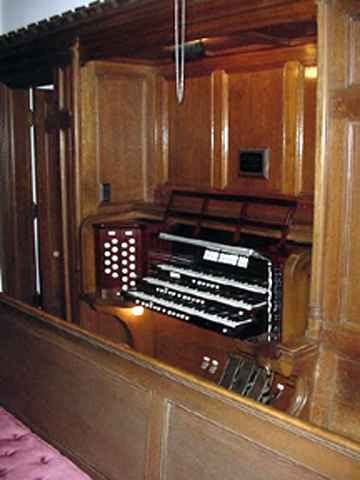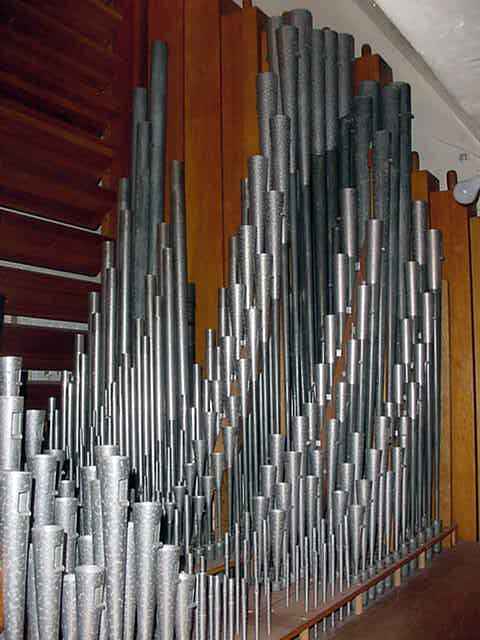|
Trinity Episcopal Church Bethlehem, PA Aeolian-Skinner Organ Company, 1955 3 Manuals, 27 Ranks |

|
 Swell Division |

|
|
Trinity Episcopal Church Bethlehem, PA Aeolian-Skinner Organ Company, 1955 3 Manuals, 27 Ranks |

|
 Swell Division |

|
| Great | Swell | ||
|---|---|---|---|
| 8' | Principal | 8' | Rohr Flote |
| 8' | Bourdon | 8' | Viole de-Gambe |
| 4' | Octave | 8' | Viole Celeste |
| 4' | Flute Harmonique | 4' | Spitz Flote |
| Fourniture IV | Plein Jeu III | ||
| 16' | Contre Hautbois | ||
| 8' | Trompette | ||
| 4' | Clairon | ||
| Tremulant | |||
| Choir | Pedal | ||
| 8' | Cor de-Nuit | 32' | Resultant |
| 8' | Dulciana | 16' | Contre Basse |
| 8' | Unda Maris (TC) | 16' | Rohr Bourdon (Sw) |
| 4' | Koppel Flote | 8' | Octave |
| 2 2/3' | Nazard | 8' | Rohr Flote (Sw) |
| 2' | Block Flote | 4' | Choral Bass |
| 1 3/5' | Tierce | 16' | Contre Hautbois (Sw) |
| 8' | Cromorne | 8' | Contre Hautbois (Sw) |
| Tremulant | 4' | Contre Hautbois (Sw) |
The Aeolian-Skinner pipe organ in Trinity Church was built in Boston in 1954-55. When the construction of a new organ for Trinity Church was initially proposed, a two-manual organ was projected. However, in the process of negotiating a contract for an organ that would suit the needs of Trinity Church, the specifications grew, and ultimately an organ of three manuals was built. Bill Zeuch who was Vice President of the Aeolian-Skinner Organ Company originally designed the organ. The original contract to build the organ at a cost of $28,430 was signed in August, 1951. To accommodate such an instrument structural changes were necessary in the chancel area of the church. The Aeolian-Skinner Company, at the time with a two-year backlog, was willing to accept the church's request for a three-year payment period during which funding for structural changes could be arranged and implemented.
In March of 1954 the church authorized the engineering and production to commence. The cost was increase to $30,793 and installation took place in the fall of 1955. Mr. Zeuch had retired and the project was taken over by G. Donald Harrison., internationally know as a genius of pipe organ tonal design. Harrison proposed modifications to the original specification. A Swell Rohrflote replaced the originally proposed Stopped Diapason because this type of tone blends better with the strings and gives a quasi Principal effect in the Swell. And a 4' Spitzflote replaced the originally proposed Flute Triangulaire because, as the only 4' stop in the Swell, it is a hybrid stop acting both as a Flute and as a Principal. In the Choir Organ, a 8' Cor-de-Nuit was selected to replace a Concert Flute for the purpose of blending with the mutations and the Cromorne. In the Pedal division, the 16' Rohr Bourdon was extended from the Swell instead of having an independent 16' Bourdon of 32 pipes. This allowed the stop to be under expression for accompanying the strings of the instrument. The 8' Rohrflote was also borrowed from the Swell for soft work. A 4' Choral Bass, extending from the Contre Basse was added to give the Pedal organ a 4' stop which Harrison felt was extremely important in carrying the impact of the Pedal Organ .
In 1971 Mr. Arthur Birchall, for many years a leading finisher with Aeolian-Skinner, was in Bethlehem working on an installation for another builder. In visiting Trinity Church and the organ on which he had a part in its construction, he agreed with the feasibility of modifying the Great to provide a 4 rank Fourniture in place of the 2 rank Grave Mixture and install a 1-3/5' Tierce in the place of the 8' Gemshorn in the Choir organ. The pipes were crafted by a former Aeolian-Skinner pipe maker who worked with Mr. Harrison prior to the dissolution of the company. The installation was completed by Mr. Birchall, in the fall of 1972 with splendid result. The project was funded almost entirely by private contributions by Mr. Harrison and offerings received at a series of noon-day recitals.
In 1979 the combination action in the console
began to need attention. In the spring of
1986 the need for re-leathering the chests became
more and more obvious. A contract was ultimately warded to John
Hendriksen of Pembroke, Massachusetts, brought to Aeolian-Skinner by Mr.
Harrison in the early 1950's. The work commenced in
the spring of 1987 and completed in the summer.
In 1993 all reeds of the organ were cleaned,
repaired and regulated by Mr. Hendriksen.